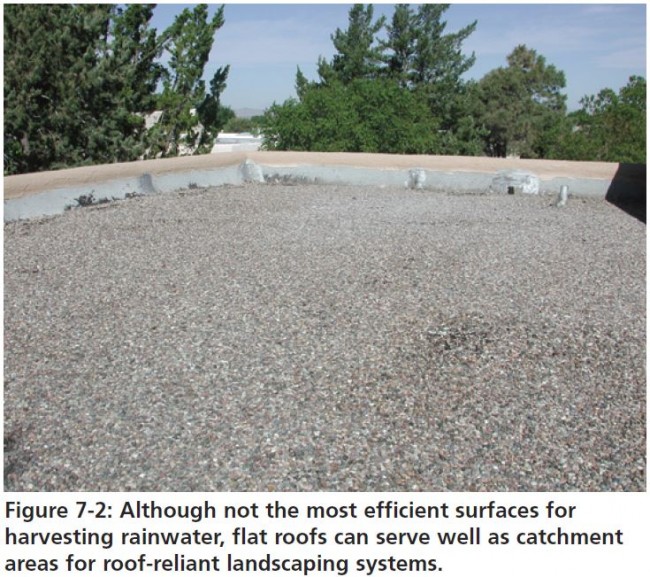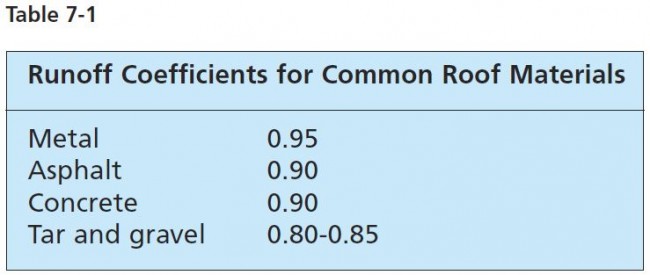The PermaDesign Weblog, with Nate Downey and Melissa McDonald!
Archives from January 2016
Roof-Reliant Landscaping™ Step 16D: Water Conveyance - Horizontal Run
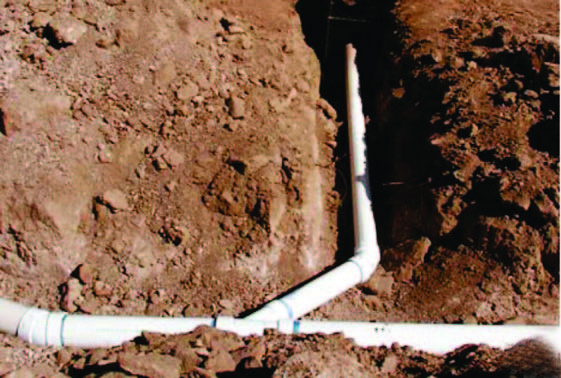
Figure 8-8: Conveyance pipes being installed, which will carry water to a cistern.
Almost all cistern systems require conveyance pipes that run perpendicular to the system's verticaldrop line. To maintain positive drainage toward the cistern, however, these pipes only appear to be horizontal and, in fact, must not be level. The horizontal runs should drop a minimum of onequarter inch per linear foot until they connect with your storage area.
01/25/2016 | (0) Comments
Roof-Reliant Landscaping™ Step 16C: Water Conveyance - Vertical Drop
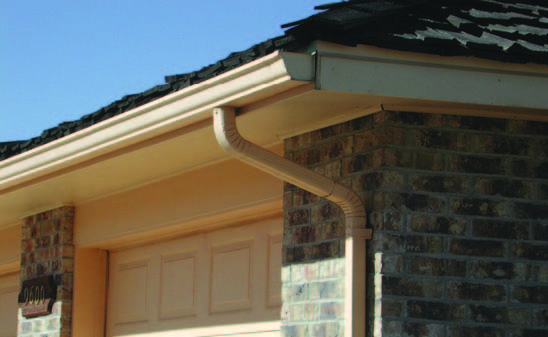
Figure 8-3: Photo of a downspout. Downspouts funnel water
from gutters along a vertical drop.
In most water harvesting systems, there is at least one place in the conveyance system with a sharp vertical drop. From pitched roofs, this is typically a downspout. From flat roofs, this is usually the arc of projected precipitation off of the edge of a canale. Harvesting water that free-falls from a canale imposes a need to efficiently direct the runoff. This manual offers three methods to deal with the vertical-drop issues associated with canales: funnel drains, downspout-canale connections and in-wall drainpipes.
01/23/2016 | (2) Comments
Roof-Reliant Landscaping™ Step 16B: Water Conveyance - Important Tips
Important Tips
Drainage mistakes close to the foundation of a wall should be avoided no matter what the cost. When installing your funnel drains:
• Be sure water flows away from buildings. When water collects against a wall, it can create expensive structural damage and mold problems.
• Do not cut corners by eliminating the liner. Without it, you will harvest much less water, and the roof water that you do not harvest may soak into the soil at the foundation of your home.
• Ensure that the connections between parts and materials are tight and secure. Although conveyance piping does not technically move water under pressure, the force under a canale can be substantial.
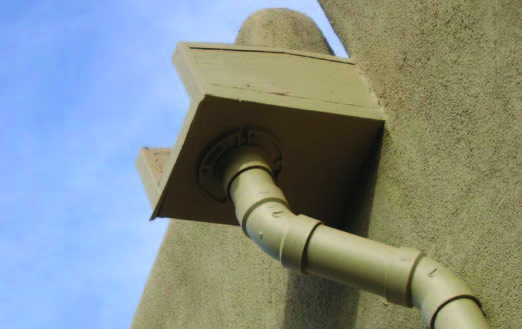
Figure 8-5: A toilet flange can connect a canale to a downspout.
01/22/2016 | (2) Comments
Roof-Reliant Landscaping™ Step 16A: Water Conveyance - Concentration
Conveyance systems move roof water from precipitation collection surfaces to cisterns. In a roof-reliant landscape, a typical conveyance system will perform five functions:
1. Concentration
2. Vertical drop
3. Horizontal run
4. Filtration
5. Delivery
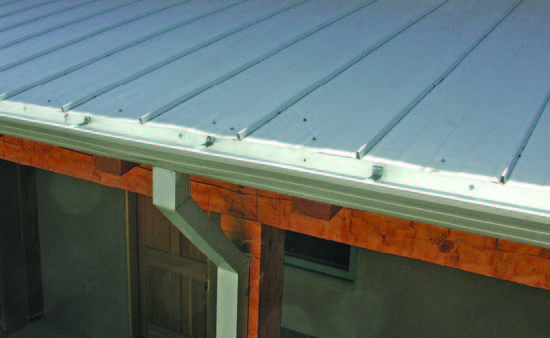
Figure 8-1: Gutters collect water from a pitched metal roof.
01/21/2016 | (0) Comments
Roof-Reliant Landscaping™ Step 15D: Water Collection - Roof Materials (Flat Roofs)
As discussed above, while so-called flat roofs are not the preferred type of roof from a water harvesting perspective, they are quite effective at harvesting water nonetheless. When the collected water is designated for nonpotable uses such as watering plant material, the drawbacks, in terms of both water quality and quantity, are relatively minor. If your roof happens to be flat, be assured that you can create a totally roof-reliant landscape with any of the flat roof materials commonly used in New Mexico. (See Figure 7-2.)
Asphalt. A wide variety of asphalt-based roofing materials is available for flat roofs, including tar and gravel, built-up roofs, cap sheet, torch down and roll roofing. The advantage of asphalt products is their relatively low cost. The downside of these materials is that the asphalt will slowly leach toxins into your cistern system. However, your plants will be able to tolerate these low levels of toxins without difficulty. (See Figure 7-3.)
Rubber. An increasingly popular kind of roof is made primarily out of a rubber product known as ethylene propylene diene monomer (EPDM). Seamless, long lasting, durable and less toxic than asphalt, EPDM is becoming more pricecompetitive. It has none of the strong odors associated with asphalt and is sometimes touted as a “green” roof since the rubber content can be made out of recycled materials.
01/19/2016 | (2) Comments
Roof-Reliant Landscaping™ Step 15C: Water Collection - Roof Materials (Pitched Roofs)
Pitched roofs are constructed using a wide variety of materials, including metal, tile, shingle, slate and treated wood. From a water harvesting perspective, metal is the preferred pitched roof material because of its high runoff coefficient and because other more-porous roof materials can leach toxins into your cistern and, ultimately, to the root zones of your plants.
Metal. A pitched, sheet metal roof is the cleanest and most efficient collection surface available. It provides a smooth surface that conveys water efficiently. Sheet metal is competitively priced throughout much of New Mexico and lasts a long time under normal conditions. Metal tile is also available, but it is more expensive and less efficient at collecting water. Metal is a relatively durable and longlasting roof material, and it is priced in the mid-range for roof materials. (See Figure 7-1.)
Asphalt. Asphalt roofs are popular because they are made from some of the least expensive roofing materials available. Asphalt shingles are typically made of either a paperbased or a fiberglass-based mesh soaked in asphalt. Due to the leaching that can occur from asphalt shingles, this is a poor roof choice from a water quality perspective.
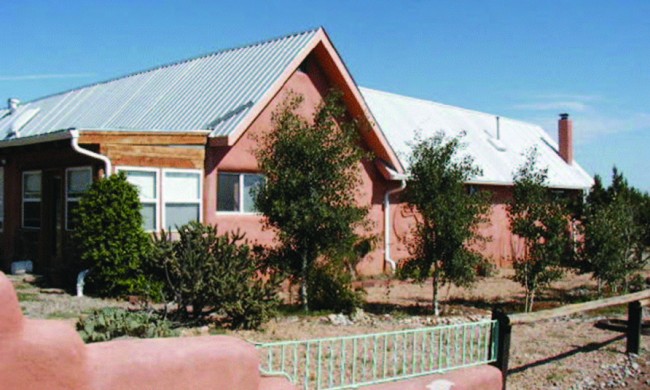
01/17/2016 | (0) Comments
Roof-Reliant Landscaping™ Step 15B: Water Collection - Runoff Coefficients
When calculating the amount of runoff that can be harvested from a roof, it is common to include a runoff coefficient. This coefficient accounts for the fact that some roof surfaces are more efficient than others at collecting rainwater. For example, a pitched metal roof is typically the most efficient type of roof for collecting water, delivering 95% of the water that falls on it (except for some heavy snowfalls). Conversely, a flat tar-and-gravel roof is typically the least efficient roof type, delivering 80-85% of the water that falls on it. Table 7-1 lists the runoff coefficients for common roof materials.
Please note that the figures in Table 7-1 are estimates. In a very light rain event, the runoff coefficient can equal 0.00, since no rainwater will flow through your catchment system into your cistern.
Throughout the text, the common term “flat” is used to describe both flat and seemingly flat, low-sloped roofs.
For water quality issues, contact the New Mexico Environment Department Water Quality Bureau.
In Chapter 3, Sizing Your Cistern, the runoff coefficient was not included in the calculations you made when estimating anticipated rainwater harvests. Instead, you were encouraged to use a generally cautious approach to predicting rooftop rainwater harvests. The decrease in harvested rainwater due to loss from the runoff coefficient was one of the reasons for this. If you would now like to include the runoff coefficient in your rainwater harvesting calculations, you can more accurately predict the net runoff.
01/15/2016 | (0) Comments
Roof-Reliant Landscaping™ Step 15A: Water Collection - The “Pitch” for Pitched Roofs
When it comes to rainwater harvesting in New Mexico, the major question concerning your roof is whether it is pitched or flat.8 Pitched roofs are slightly more efficient than flat roofs for water harvesting, but flat roofs are quite suitable surfaces for rainwater collection as well.
The “Pitch” for Pitched Roofs
When it comes to harvesting precipitation, pitched= roofs provide a cleaner resource than flat roofs because less debris accumulates on them. Flat roofs have parapets that prevent debris from being blown or sliding off the roof. When significant storm events occur, anything on a pitched roof will quickly wash away, while at least some portion of the debris on a flat roof is left behind to slowly decompose on the watercollection surface.
Many materials used in flat roofs leach low levels of toxic chemicals, but as long as your cistern is locked and marked “nonpotable,” this should not be a problem.9 Plants should thrive as a result of being watered by your harvested precipitation.
Pitched roofs collect a greater amount of precipitation than flat roofs for the following reasons:
1. Less precipitation evaporates off of pitched roofs than off of flat roofs because the angle of a pitched roof directs precipitation more immediately to the conveyance system. Since the precipitation landing on a flat roof moves much more slowly than that landing on a pitched roof, the sun, wind and ambient air have an increased amount of time to cause evaporation.
2. The gravel that is typically part of a flat-roof system prevents rain and snow delivered from light-precipitation events from making it to the system’s conveyance piping. Water is inhibited from flowing toward the initial conveyance points, and the gravel, with its multiple surfaces, causes significant evaporation, especially when conditions just prior to precipitation were hot and dry.
3. Given an identical building footprint, the square footage of a pitched roof is typically larger than that of a flat roof. This is due to the overhangs associated with pitched roofs, which add catchment area.
4. The conveyance system for a pitched roof is usually slightly less expensive to install and slightly more efficient at transporting water than that of a typical flat roof. (This will be made more apparent in Chapter 8, Water Conveyance.)
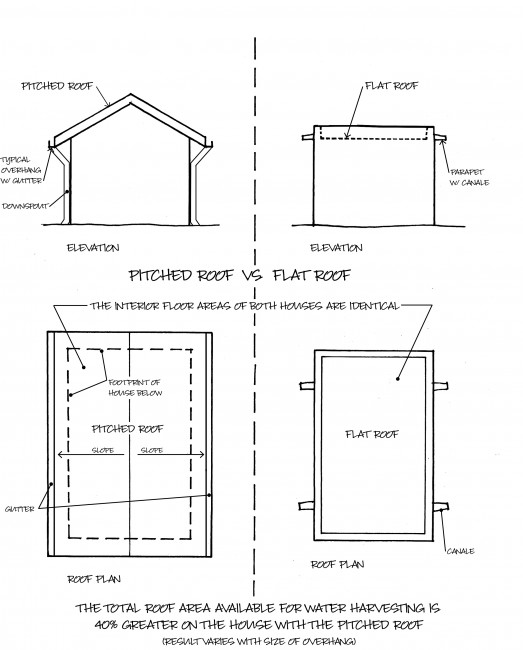
01/13/2016 | (0) Comments
Oil and Water Shouldn’t Mix

This article does not bode well for many people. It's just plain awful. but it does give folks another reason to consider rainwater harvesting.
01/11/2016 | (0) Comments
Roof-Reliant Landscaping™ Step 14E: Water Income
It is also extremely helpful to know when in the year it is most likely to rain. On average, the “typical” year's rainfall in New Mexico will be delivered as follows:
• One-eighth will be harvested in Season 1 (September, October and November).
• One-quarter will fall in Season 2 (typically December, January and February).
• One-eighth will be harvested in Season 3 (March, April and May).
• One-half of the year’s precipitation will come in Season 4 (June, July and August, in most parts of the state).
Based upon recent data, precipitation patterns may be changing and New Mexico’s summer “monsoon” season may not be as predictable or consistent as in the past. Nevertheless, New Mexico continues to receive a large percentage of its annual precipitation during the warmer months.
01/11/2016 | (0) Comments
